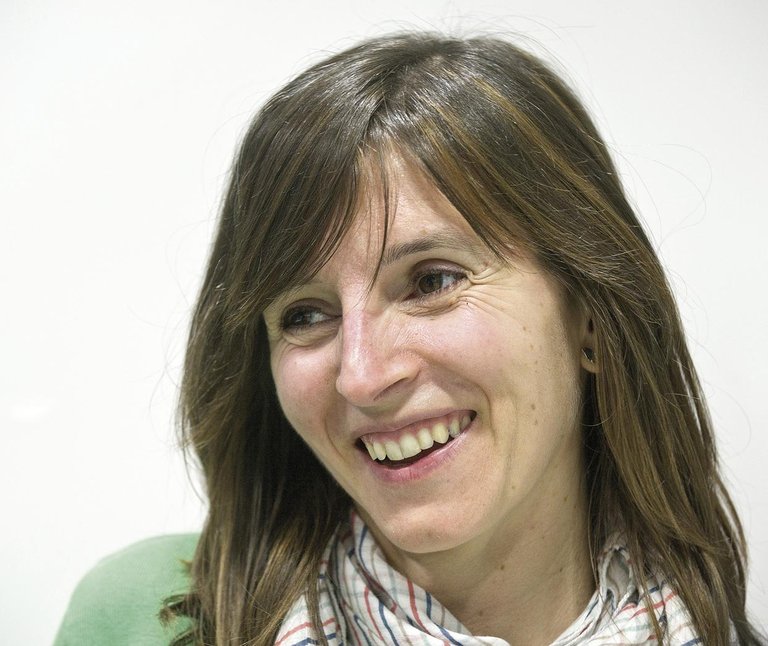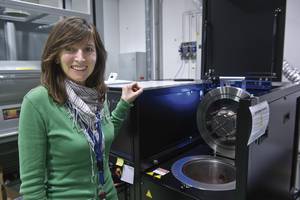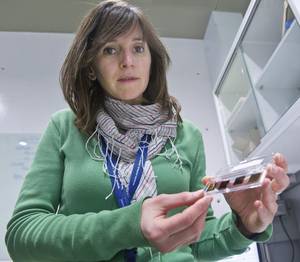"I don't want to imagine my life without science"

We are more immersed in science and should not get so much into the financial arena. For this we have another person, the director general. But it is true that as a small company we have to do everything. We started in April 2010, at that time I was alone and therefore I had to do everything. The account has now been better defined.
But, for example, today I don't do any experiments. The higher you are in the workplace, the less laboratory work you do in your daily activity. Above all I am with clients, I write projects, I look for ways to develop new applications of graphene, and I do things like that. I go to the lab every day, but I don't usually spend many hours there. I say it with a little grief. But I think that is natural or normal progression.
In the end we are a very small company, we are only six people. So, we can't have a whole building just for us. In addition, we need a lot of equipment to conduct graphene related research. And that's why we're inside cic-nanoGUNE, in Donostia. We have offices there and we also have a laboratory for rent. We paid money to be there. But we feel that residency is ours.
I don't know if to solve the problems, but it is curious or differential. It has many properties in one material: normally, in order to have all these properties you must join many materials. In this case it is a single material so it is very interesting. In addition, it is a material made exclusively of carbon atoms, and it is very important to have two-dimensional material. It is very fine, they are sheets of a single atom of thickness (it is what we call of two dimensions). It is the first isolated two-dimensional material. Isolated in 2004, other two-dimensional materials have since been isolated, but graphene was the first.
Yes, they say that every time you write in pencil pieces of graphene fall. By definition, graphene is a single layer of atoms. The truth is that it is very difficult to extract layers of a single atom from a pencil, but from this idea was isolated in 2004 by two scientists from Manchester, Andre Geim and Constantin Novoselov. The graphite was being cleaned, it was decided to analyze what was thrown into the trash and found graphene.
In graphenea we generate graphene. Graphite cleaning is not a suitable method for obtaining large sheets, for example. We use another synthetic process, the deposition of carbon atoms, to achieve a quality that allows graphene to be used in the industry. We work with companies, universities and research centers for many applications. For example, with NOKIA we are working to use graphene on mobile phone screens. Or to make flexible batteries. Or mechanically improve composites, increase conductivity, etc.

Yes, yes. In fact, the structure of graphene was published in 1947. This publication was theoretical; graphene did not exist. Years later it was shown that it is possible to isolate graphene. More than 50 years have passed, but in the end the theory is very useful.
It is a very ambitious project. The European Union has granted 1,000 million for ten years. We are 74 partners, one of them, and so far they have given money for two and a half years. It is about to start in October and research is going to be done for many applications. From the point of view of Graphenea it has been very positive, not only for money, but because we want to market products with graphene.
I don't know. I was at ease, left for a year and stayed 12 years. There were other Basques and there was a very nice atmosphere. People there are also very nice, and I have never felt foreign. When I played the Scottish team we were in favor of Scotland (laughs). They always lost.
As a chemist, I got into the world of polymers and did a thesis on microgels. It had medical applications: they were polymers for intraocular contact lenses.
Then I spent three years in research work, even in polymers. And it was not very theoretical, it was practical, but it was far from the market and I wanted to do something close to the market. In the end I wanted to see the results. And I decided to enter the industrial world. It was in the right place. I started working at a pharmaceutical company near Glasgow.
I know a lot of people who after studying in Britain have gone into the business world to do more practical research.
For example, in this area there are very few companies here. There are other areas, but in the biomedical field very few companies. So I changed the area.
Professionally it was very good. In the interview they did to me, the truth is that I didn't even know what graphene was, but I found it quite interesting. Professionally I am very happy.
And personally, I don't know. It hurts, but it was a stage and had to close it. Since then I have returned almost every year to Scotland. But I always look forward, and now I am happy.
Hard! I don't want to imagine my life if there's no science... I have long realized that I wanted to investigate. I liked it. In the end it is learning new things and knowing more and more. It is not something that is forgotten after eight hours of work. That makes this work a vocation.
Yes, a lot. I, for example, last year was on almost every continent. And I like to travel, but in the end the rhythm is excessive for the body; traveling twice a month is too much (United States, Japan...). But so, for example, at congresses, you receive a lot of information; being here you would not receive it. That's why I like to travel. Of course, it's not the same to go on vacation to work, but good. In the end, I think it's very positive.
Yes. In the end, we mean to everyone what we do. In short, we are very interested in our research and we like to say it to others. We value it very positive... Someone wants to know what I do! And he wants to understand it. Many times, for example, taking a drink at the bar and your friends ask you... "And what is that? And what is it for? ". And we respond happy.
--> Listen to the interview in Norteko Ferrokarrilla
Buletina
Bidali zure helbide elektronikoa eta jaso asteroko buletina zure sarrera-ontzian












